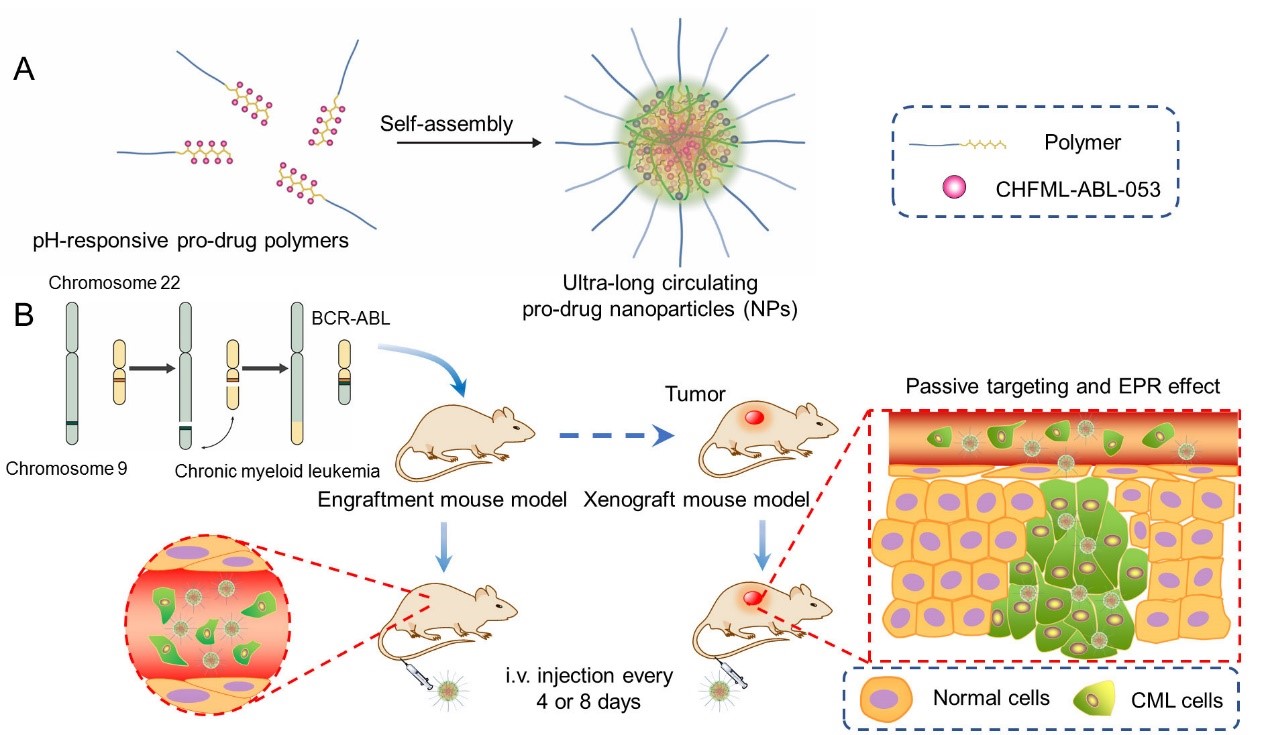An ultra-long circulating nanomaterial by conjugating CHMFL-ABL-053 to an amphiphilic polymer and self-assembling into a nanoparticle (NP) with a high loading (~10.3%) was prepared by FU Liyi and ZOU Fengming, who are doctors of Prof. LIU Qingsong and Prof. LIU Jing’s group from the Institute of Health & Medical Technology, Hefei Institutes of Physical Science,
The formulation greatly improved its solubility and drastically extended its circulation half-life from ~5.3 to ~117 hours (>20-fold).
Chronic myeloid leukemia (CML) is a clonal hematopoietic stem cell myeloproliferative disease, which is primarily caused by the chromosomal translocation between the Abelson (ABL) gene and the breakpoint cluster region (BCR) gene. Although the FDA-approved BCR-ABL inhibitors, such as Imatinib and Dasatinib etc. could greatly improve the 10-year survival rate of the patients, their off-targets, such as DDR1/2 and c-kit, may lead to the decrease of mast cells, vascular adverse events and other undesired side effects.
Previoulsy related research was conducted by Prof. LIU Qingsong and Prof. LIU Jing’s group. And a novel BCR-ABL inhibitor CHMFL-ABL-053 was developed, which had a better selectivity to the target of BCR-ABL over other protein kinases. However, like all of this class of inhibitors, CHMFL-ABL-053 must be treated orally every day due to its short half-life, which would not only increase the economic burden of patients, but also lead to cumulative toxicities.
This time the team pushed their work further to make a modification based on their previous work. In the 150 days long-term engraftment model experiment,long intravenous dosing intervals of the NPs (every 4 or 8 days) exhibited much better survival and negligible toxicities as compared to daily oral administration of the inhibitor.
Moreover, the NPs showed excellent inhibition of tumor growth in the subcutaneous xenograft model. The excellent anti-leukemic efficacy of the NPs in the long injection cycle on both models might provide a novel, effective and safe therapeutic strategy for BCR-ABL-positive CML.
This work was supported by the Strategic Priority Research Program of the Chinese Academy of Sciences, the Natural Science Foundation of Anhui Province, the Frontier Science Key Research Program of CAS, and et al.
Link to the paper: An ultra-long circulating nanoparticle for reviving a highly selective BCR-ABL inhibitor in long-term effective and safe treatment of chronic myeloid leukemia

(A)Self-assembly of the NPs and (B) their targeting of CML on two models. (Image by the research team)
Contact:
ZHOU Shu
Hefei Institutes of Physical Science (http://english.hf.cas.cn/)
Email: zhous@hfcas.ac.cn
 Tel: +86-551-65591206
Tel: +86-551-65591206
 Fax: +86-551-65591270
Fax: +86-551-65591270
 Emai: zhous@hfcas.ac.cn
Emai: zhous@hfcas.ac.cn
 350 Shushanhu Road
350 Shushanhu Road